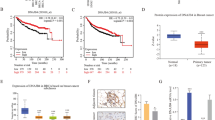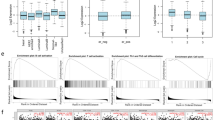Abstract
Specificity protein 1(Sp1) is a ubiquitous transcription factor and is highly expressed in breast cancer. However, its expression pattern and role in breast cancer progression remain unclear. The purpose of this study is to examine the expression pattern of Sp1 and determine its role in breast cancer progression. Immunohistochemistry (IHC) was performed on breast cancer tissues to reveal the expression pattern of Sp1. Spearman rank correlation was used for clinical statistics. Gene and protein expressions were monitored by IHC analysis, quantitative polymerase chain reaction, and Western blot. Wound-healing and Transwell assays were conducted to assess the role of Sp1 in breast cancer. Co-immunoprecipitation, deletion mutagenesis, chromatin immunoprecipitation, and dual luciferase reporter gene assays were used for investigation of the regulatory network. Sp1 expression was downregulated in late stage breast cancer and in highly invasive breast cancer cell lines. Expression of Sp1 was negatively correlated with TNM staging (P = 0.002) and metastasis status (P = 0.023). Overexpression of Sp1 inhibited breast cancer cell migratory and invasive abilities, whereas knockdown of GTP-binding RAS-like 3 (DIRAS3, also known as ARHI, NOEY2) attenuated the inhibitory effects. Moreover, re-expression of DIRAS3 abolished Sp1 knockdown-mediated cell migration and invasion. Jumonji domain containing 2A (JMJD2A) inhibited Sp1 autoregulation and explains Sp1 expression pattern in breast cancer. Sp1 negatively regulated breast cancer metastasis by transcriptional activation of DIRAS3. Inhibition of Sp1 autoregulation by JMJD2A contributed to Sp1 expression pattern in breast cancer. Our findings provided evidence that targeted therapy against Sp1 might be useful in early stage breast cancer. However, in late stages, development of Sp1 activator may be more promising for breast cancer treatments.







Similar content being viewed by others
Abbreviations
- Sp1:
-
Specificity protein 1
- DIRAS3:
-
GTP-binding RAS-like 3
- JMJD2A:
-
Jumonji containing domain 2A
- qRT-PCR:
-
Quantitative real-time polymerase chain reaction
- ChIP:
-
Chromatin immunoprecipitation
- Co-IP:
-
Co-immunoprecipitation
- ATCC:
-
American type culture collection
- DMEM:
-
Dulbecco’s modified eagle medium
- FBS:
-
Fetal bovine serum
- IHC:
-
Immunohistochemistry
References
Abuidris DO, Elsheikh A, Ali M, Musa H, Elgaili E, Ahmed AO, Sulieman I, Mohammed SI (2013) Breast-cancer screening with trained volunteers in a rural area of Sudan: a pilot study. Lancet Oncol 14(4):363–370
Lee EY, Muller WJ (2010) Oncogenes and tumor suppressor genes. Cold Spring Harb Perspect Biol 2(10):a3236
Li L, Davie JR (2010) The role of Sp1 and Sp3 in normal and cancer cell biology. Ann Anat 192(5):275–283
Kadonaga JT, Carner KR, Masiarz FR, Tjian R (1987) Isolation of cDNA encoding transcription factor Sp1 and functional analysis of the DNA binding domain. Cell 51(6):1079–1090
Guo D, Wu B, Yan J, Li X, Sun H, Zhou D (2012) A possible gene silencing mechanism: hypermethylation of the Keap1 promoter abrogates binding of the transcription factor Sp1 in lung cancer cells. Biochem Biophys Res Commun 428(1):80–85
Hsu TI, Wang MC, Chen SY, Yeh YM, Su WC, Chang WC, Hung JJ (2012) Sp1 expression regulates lung tumor progression. Oncogene 31(35):3973–3988
Yue L, Li L, Liu F, Hu N, Zhang W, Bai X et al (2013) The oncoprotein HBXIP activates transcriptional coregulatory protein LMO4 via Sp1 to promote proliferation of breast cancer cells. Carcinogenesis 34(4):927–935
Banerjee S, Sangwan V, McGinn O, Chugh R, Dudeja V, Vickers SM, Saluja AK (2013) Triptolide-induced cell death in pancreatic cancer is mediated by O-GlcNAc modification of transcription factor Sp1. J Biol Chem 288(47):33927–33938
Black AR, Black JD, Azizkhan-Clifford J (2001) Sp1 and kruppel-like factor family of transcription factors in cell growth regulation and cancer. J Cell Physiol 188(2):143–160
Zheng Y, Ritzenthaler JD, Sun X, Roman J, Han S (2009) Prostaglandin E2 stimulates human lung carcinoma cell growth through induction of integrin-linked kinase: the involvement of EP4 and Sp1. Cancer Res 69(3):896–904
Jiang Y, Wang L, Gong W, Wei D, Le X, Yao J et al (2004) A high expression level of insulin-like growth factor I receptor is associated with increased expression of transcription factor Sp1 and regional lymph node metastasis of human gastric cancer. Clin Exp Metastasis 21(8):755–764
Mitchell DC, Stafford LJ, Li D, Bar-Eli M, Liu M (2007) Transcriptional regulation of KiSS-1 gene expression in metastatic melanoma by specificity protein-1 and its coactivator DRIP-130. Oncogene 26(12):1739–1747
DeFino MC, Wacker JL, Lyssand JS, Wang EH, Hague C (2010) Differential regulation of GPR54 transcription by specificity protein-1 and partial estrogen response element in mouse pituitary cells. Biochem Biophys Res Commun 393(4):603–608
Bu Y, Gao L, Gelman IH (2011) Role for transcription factor TFII-I in the suppression of SSeCKS/Gravin/Akap12 transcription by Src. Int J Cancer 128(8):1836–1842
Covington KR, Brusco L, Barone I, Tsimelzon A, Selever J, Corona-Rodriguez A, Brown P, Kumar R, Hilsenbeck SG, Fuqua SA (2013) Metastasis tumor-associated protein 2 enhances metastatic behavior and is associated with poor outcomes in estrogen receptor-negative breast cancer. Breast Cancer Res Treat 141:375–384
Perera RM, Bardeesy N (2012) On oncogenes and tumor suppressor genes in the mammary gland. Cold Spring Harb Perspect Biol 4:a013466. doi:10.1101/cshperspect.a013466
Yu Y, Xu F, Peng H, Fang X, Zhao S, Li Y et al (1999) NOEY2 (DIRAS3), an imprinted putative tumor suppressor gene in ovarian and breast carcinomas. Proc Natl Acad Sci USA 96(1):214–219
Wang L, Hoque A, Luo RZ, Yuan J, Lu Z, Nishimoto A et al (2003) Loss of the expression of the tumor suppressor gene DIRAS3 is associated with progression of breast cancer. Clin Cancer Res 9(10 Pt 1):3660–3666
Janssen EA, Ovestad IT, Skaland I, Soiland H, Gudlaugsson E, Kjellevold KH et al (2009) LOH at 1p31 (DIRAS3) and proliferation in lymph node-negative breast cancer. Cell Oncol 31(5):335–343
Li Y, Liu M, Zhang Y, Han C, You J, Yang J et al (2013) Effects of DIRAS3 on breast cancer cell biological behavior regulated by microRNA-221. Tumour Biol 34(6):3545–3554
Yu Y, Luo R, Lu Z, Wei FW, Badgwell D, Issa JP et al (2006) Biochemistry and biology of DIRAS3 (DIRAS3), an imprinted tumor suppressor gene whose expression is lost in ovarian and breast cancers. Methods Enzymol 407:455–468
Klingauf M, Beck M, Berge U, Turgay Y, Heinzer S, Horvath P, Kroschewski R (2013) The tumour suppressor DiRas3 interacts with C-RAF and downregulates MEK activity to restrict cell migration. Biol Cell 105(2):91–107
Lu Z, Luo RZ, Peng H, Huang M, Nishmoto A, Hunt KK et al (2006) E2F-HDAC complexes negatively regulate the tumor suppressor gene DIRAS3 in breast cancer. Oncogene 25(2):230–239
Feng W, Lu Z, Luo RZ, Zhang X, Seto E, Liao WS, Yu Y (2007) Multiple histone deacetylases repress tumor suppressor gene DIRAS3 in breast cancer. Int J Cancer 120(8):1664–1668
Luo RZ, Peng H, Xu F, Bao J, Pang Y, Pershad R et al (2001) Genomic structure and promoter characterization of an imprinted tumor suppressor gene DIRAS3. Biochim Biophys Acta 1519(3):216–222
Safe S, Abdelrahim M (2005) Sp transcription factor family and its role in cancer. Eur J Cancer 41(16):2438–2448
Yang X, Wang J, Liu S, Yan Q (2014) HSF1 and Sp1 regulate FUT4 gene expression and cell proliferation in breast cancer cells. J Cell Biochem 115(1):168–178
Badgwell DB, Lu Z, Le K, Gao F, Yang M, Suh GK et al (2012) The tumor-suppressor gene DIRAS3 (DIRAS3) suppresses ovarian cancer cell migration through inhibition of the Stat3 and FAK/Rho signaling pathways. Oncogene 31(1):68–79
Li LL, Xue AM, Li BX, Shen YW, Li YH, Luo CL et al (2014) JMJD2A contributes to breast cancer progression through transcriptional repression of the tumor suppressor DIRAS3. Breast Cancer Res 16(3):R56. doi:10.1186/bcr3667
Nicolas M, Noe V, Jensen KB, Ciudad CJ (2001) Cloning and characterization of the 5′-flanking region of the human transcription factor Sp1 gene. J Biol Chem 276(25):22126–22132
Gray SG, Iglesias AH, Lizcano F, Villanueva R, Camelo S, Jingu H et al (2005) Functional characterization of JMJD2A, a histone deacetylase- and retinoblastoma-binding protein. J Biol Chem 280(31):28507–28518
Whetstine JR, Nottke A, Lan F, Huarte M, Smolikov S, Chen Z et al (2006) Reversal of histone lysine trimethylation by the JMJD2 family of histone demethylases. Cell 125(3):467–481
Kwak HJ, Park MJ, Cho H, Park CM, Moon SI, Lee HC et al (2006) Transforming growth factor-beta1 induces tissue inhibitor of metalloproteinase-1 expression via activation of extracellular signal-regulated kinase and Sp1 in human fibrosarcoma cells. Mol Cancer Res 4(3):209–220
Klose RJ, Yamane K, Bae Y, Zhang D, Erdjument-Bromage H, Tempst P, Wong J, Zhang Y (2006) The transcriptional repressor JHDM3A demethylates trimethyl histone H3 lysine 9 and lysine 36. Nature 442(7100):312–316
Huang Y, Fang J, Bedford MT, Zhang Y, Xu RM (2006) Recognition of histone H3 lysine-4 methylation by the double tudor domain of JMJD2A. Science 312(5774):748–751
Lee J, Thompson JR, Botuyan MV, Mer G (2008) Distinct binding modes specify the recognition of methylated histones H3K4 and H4K20 by JMJD2A-tudor. Nat Struct Mol Biol 15(1):109–111
Mallette FA, Richard S (2012) JMJD2A promotes cellular transformation by blocking cellular senescence through transcriptional repression of the tumor suppressor CHD5. Cell Rep 2(5):1233–1243
Zhang D, Yoon HG, Wong J (2005) JMJD2A is a novel N-CoR-interacting protein and is involved in repression of the human transcription factor achaete scute-like homologue 2 (ASCL2/Hash2). Mol Cell Biol 25(15):6404–6414
Zhang Y, LeRoy G, Seelig HP, Lane WS, Reinberg D (1998) The dermatomyositis-specific autoantigen Mi2 is a component of a complex containing histone deacetylase and nucleosome remodeling activities. Cell 95(2):279–289
Acknowledgments
This work was supported by the National Natural Science Foundation of China (No. 81172897). We thank Dr. Ralf Janknecht from Department of Biochemistry and Molecular Biology, Mayo Clinic College of Medicine and Dr. Hsing-Jien Kung from UC Davis Cancer Center for JMJD2A expression plasmids, and Dr. Jun Fujita from Department of Clinical Molecular Biology, Kyoto University for the Sp1 plasmid. We also feel great thanks for Dr. Zhao-Hui Wu from the Health Science Center, University of Tennessee and Dr. Joseph Washington from Laboratory for Implantable Materials and Biomaterials, Department of Mechanical Engineering, University of Maryland, Baltimore County for their helps in polishing this article and Dr. Zude Xu from Huashan Hospital, Shanghai, China for the clinical specimen and his professional help in pathological diagnosis. Dr. Liliang Li acknowledges the support from the State Scholarship Fund of China Scholarship Council for his visit to the University of Maryland School of Medicine through the joint Ph.D student programme (student No.: 201306100058), where part of this work was conducted.
Conflict of interest
The authors declare no conflict of interest.
Author information
Authors and Affiliations
Corresponding authors
Additional information
Liliang Li and Pan Gao contributed equally to this work.
Electronic supplementary material
Below is the link to the electronic supplementary material.
10549_2014_3083_MOESM1_ESM.tif
Supplementary material 1 (TIFF 2129 kb) Supplementary Fig. 1 mRNA level of Sp1 was negatively associated with that of DIRAS3 and positively associated with that of JMJD2A in MDA-MB-231 cells. a mRNA level of DIRAS3 was elevated in response to increased Sp1 mRNA level. b mRNA level of DIRAS3 was accordingly reduced along with decreased Sp1 mRNA level. c When JMJD2A was upregulated, mRNA level of Sp1 was inversely downregulated. d Knockdown of JMJD2A by specific siRNAs increased mRNA level of Sp1. *P < 0.05. siNC, negative control siRNA
10549_2014_3083_MOESM2_ESM.tif
Supplementary material 2 (TIFF 3174 kb) Supplementary Fig. 2 knockdown of DIRAS3 rescued Sp1 overexpression-suppressed breast cancer migration and invasion. a Sp1 overexpression suppressed MDA-MB-231 cells wound recovery process, whereas knockdown of DIRAS3 in Sp1-overexpressed cells alleviated the suppression mediated by Sp1 overexpression. b transwell assays confirmed that knockdown of DIRAS3 deprived the suppression of breast cancer migration and invasion by Sp1 overexpression
Rights and permissions
About this article
Cite this article
Li, L., Gao, P., Li, Y. et al. JMJD2A-dependent silencing of Sp1 in advanced breast cancer promotes metastasis by downregulation of DIRAS3. Breast Cancer Res Treat 147, 487–500 (2014). https://doi.org/10.1007/s10549-014-3083-7
Received:
Accepted:
Published:
Issue Date:
DOI: https://doi.org/10.1007/s10549-014-3083-7




